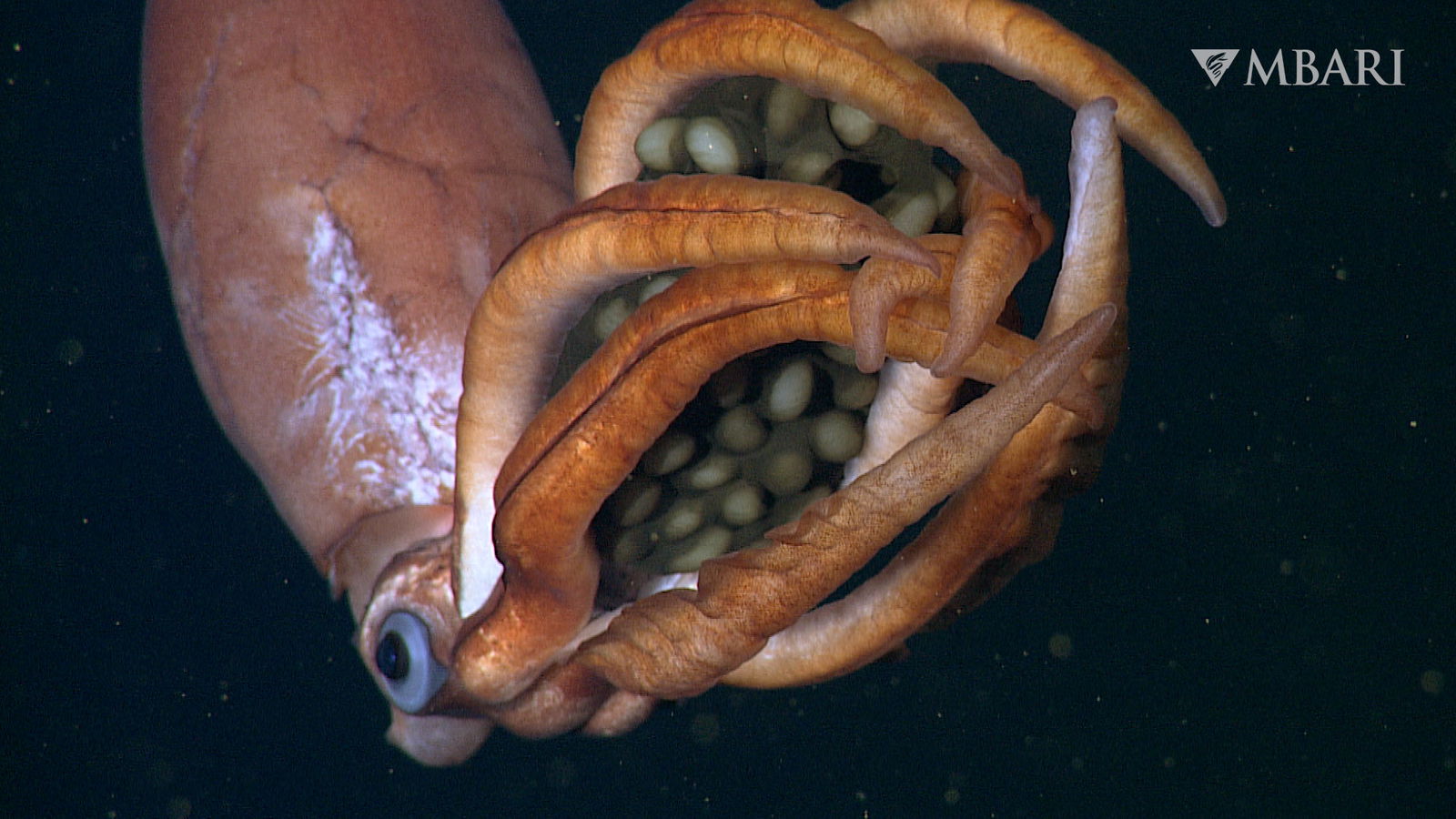Researchers at the Monterey Bay Aquarium Research Institute (MBARI), GEOMAR’s Helmholtz Centre for Ocean Research Kiel, and the University of South Florida have found a new species of squid carrying giant luminous eggs, which are the largest ever recorded for any squid species.
The new findings, published in Ecology, not only further advance our understanding of the deep ocean but also raise more questions about reproduction in cephalopods, the family that includes squids, octopuses, and cuttlefish.
Mapping Uncharted Waters
While oceans cover around 70% of the planet, only 25% of the seafloor has been identified and mapped. Much of the mapping happens with SONAR, where sound beams are sent through the water, creating images of nearby areas as the sounds bounce off objects and animals. Seafloor mapping is important as it can give Earth’s geological history, showing how the planet formed. Mapping can also reveal areas of deep sea minerals and shed light on potential new marine environments.
Though seafloor maps can give scientists details about the deep environments of the ocean, they reveal little about the species that live there. Scientists estimate that between 700,000 and 1 million species live in the ocean, with around 66% of these species not yet discovered.
Thanks to technology like remotely operated vehicles (ROVs), researchers can explore potential new habitats in the ocean’s depths where the pressures and temperatures are too extreme for divers. ROVs are small underwater machines controlled by someone on the ocean’s surface, usually using a joystick remote. These underwater explorers can be as large as an SUV or as small as a laptop.
“ROVs can provide a direct insight into the habitat and behaviour of deep-sea organisms,” Dr. Henk-Jan Hoving, a previous MBARI researcher and the current lead of the deep-sea biology working group at GEOMAR and the lead author on this study, told The Debrief. “This unique perspective helps us to study the organisms in the deep sea, and is needed to fully understand the animals, and the connections the organisms have between each other and the environment they live in. ROVs can help us to collect knowledge that we cannot obtain with other instruments, like nets.”
Using ROVs, researchers can explore previously inaccessible ecosystems with possible undiscovered species, like squids.
A Brief History of Squids
Squids have fascinated marine biologists and the general public alike for centuries. From 20,000 Leagues Under the Sea to the tentacled aliens of modern times, squids have been portrayed as mysterious, other-worldly creatures. This depiction may not be entirely inaccurate, as specific species like the giant squid have only been validated in a handful of images and videos, besides dead specimens being found in the bodies of sperm whales or occasionally washed up on a beach. The giant squid, in particular, has spawned many different myths, from the Kraken to other sea monsters.
Monitoring squid is difficult as many live in colder, deeper waters than their cephalopod counterparts. Tracking any cephalopod is difficult, as these animals can easily camouflage and, in the case of octopuses, often move from home to home, depending on potential threats like predators or competing males. Many marine biologists are working on ways to try and identify individual cephalopods, such as using the unique stripping patterns of certain octopus species.
This doesn’t apply to squids, as many don’t have individual markings or live in dens but prefer to migrate across the open ocean. As such, monitoring a squid’s or larger group of squids’ movements is nearly impossible, which has limited the amount of information marine biologists have about them.
Tracking Squid Reproduction
There are only a handful of instances where researchers have seen squids brood (or carry) eggs. In most cases, the squids deposit the eggs on the seafloor or release them as a buoyant amniotic balloon into the ocean’s currents. Seeing this new species of squid carrying eggs makes it a fascinating outlier.
“I think there are other squid species that also brood, but we just do not have enough observations yet of deep-sea squid,” Hoving stated. “For many species, mature individuals have never been collected, and many squid species have never been observed alive in their natural habitat. Therefore we just do not know how most of the known deep-sea squids exactly reproduce and if they brood. Squids that do not brood and produce one or multiple pelagic egg masses with many eggs may do so because mortality is high among juveniles, and more eggs are needed to have a critical number of individual juveniles survive. Brooding squids invest in fewer but larger eggs since the mortality among juveniles may be lower.”
Bigger Eggs May Be Better for Deeper Waters
Hoving and his colleagues have a lot of information to unpack about the newly discovered species. The squid was first seen in a 2015 expedition to Mexico’s Gulf of California when MBARI’s ROV Doc Ricketts took several videos and images of the animal. The researchers realized that the squid’s eggs were almost twice the size of those of other deep-sea brooding squids.
By comparing these videos and images with other squids, the researchers realized this squid was an entirely different species. Its eggs were around 11.6 millimetres, which the scientists believed were better suited for the colder environment where this squid lived, as the conditions in deeper waters are typically more stable and predictable.
The researchers extrapolated data from other squid studies to estimate that the eggs carried by this new squid species could take almost four years to develop and hatch, which is longer than the life cycle of many shallow-water cephalopods (most of whom only live one to two years).
As squids play both a prey and predator role in oceanic environments, understanding their life cycles and evolutionary history can help marine biologists better determine how to preserve these rich ecosystems. For Hoving, this is the next step in learning more about this mysterious squid.
“By directly observing deep-sea animals in their natural environment and by investigating their reproductive characteristics, behaviours and habitat, we collect information that can contribute to conservation strategies in the deep sea,” he stated.
Kenna Hughes-Castleberry is the Science Communicator at JILA (a world-leading physics research institute) and a science writer at The Debrief. Follow and connect with her on X or contact her via email at kenna@thedebrief.org

